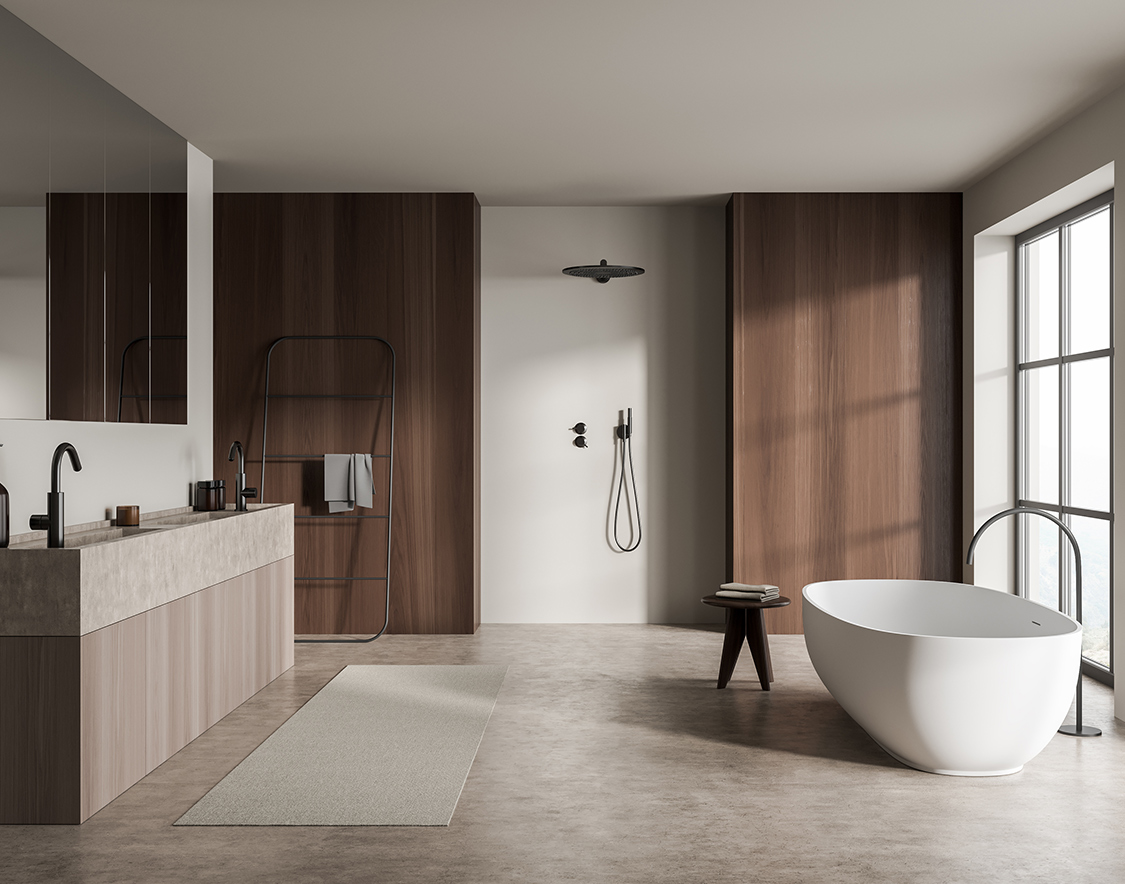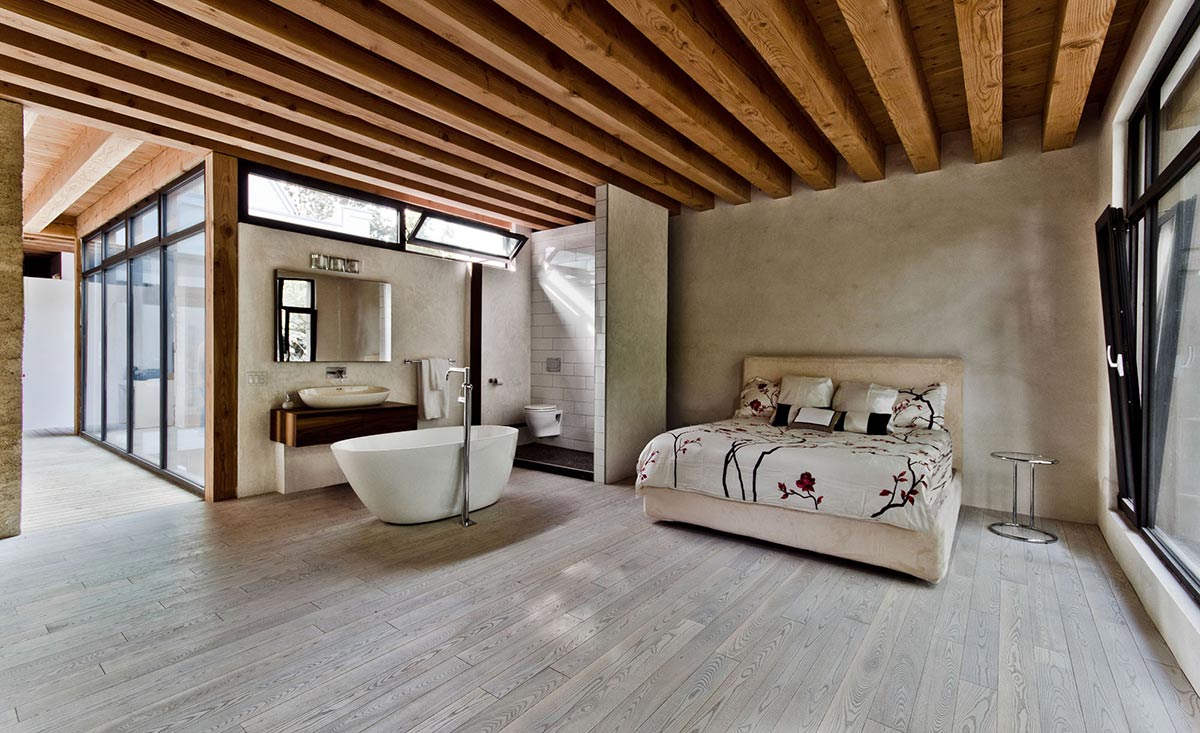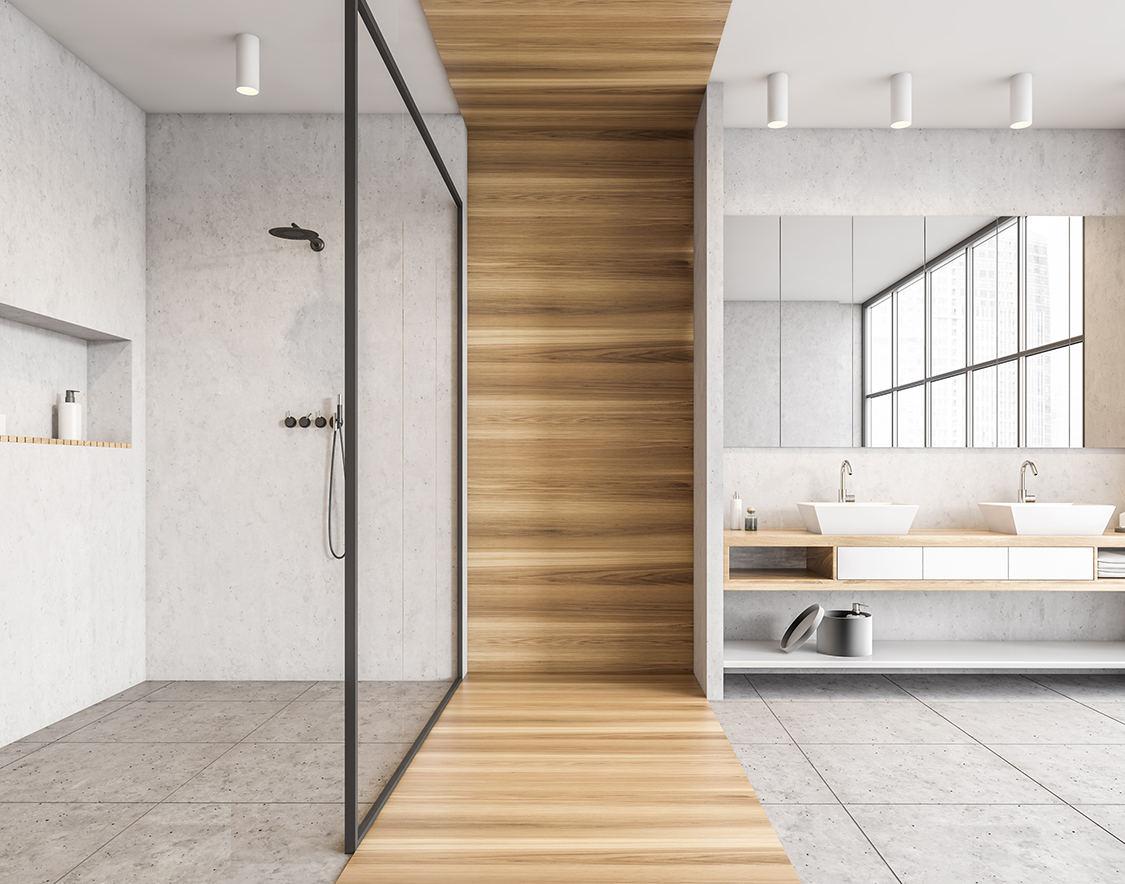Design Considerations for Doorless Bathrooms

The concept of a doorless bathroom might seem unconventional, but it presents a unique opportunity to create a space that is both functional and visually appealing. By eliminating the traditional door, you can unlock a range of design possibilities, enhancing the overall flow and aesthetics of your bathroom.
Benefits of a Doorless Bathroom
A doorless bathroom offers several advantages that can significantly improve the user experience.
- Increased Space: Removing the door eliminates the physical barrier, creating a sense of openness and maximizing the available floor space. This is particularly beneficial for smaller bathrooms where every inch counts.
- Improved Airflow: A doorless bathroom allows for better ventilation, reducing humidity and the risk of mold growth. Natural light can also penetrate the space more easily, creating a brighter and more inviting atmosphere.
- Enhanced Sense of Openness: The absence of a door creates a seamless transition between the bathroom and the adjacent space, blurring the lines between the two areas and fostering a sense of openness and connectivity.
Challenges of a Doorless Bathroom
While doorless bathrooms offer numerous benefits, they also present some design challenges that need to be carefully addressed.
- Privacy Concerns: The lack of a door raises privacy concerns, particularly if the bathroom is located in a shared space or within a busy household.
- Noise Transmission: Without a door to act as a sound barrier, noise from the bathroom can easily travel into the adjacent space, potentially disrupting the privacy and tranquility of the surrounding environment.
- Safety Hazards: A doorless bathroom can pose safety hazards, especially for young children or individuals with mobility issues. Without a physical barrier, there is a risk of accidental entry or falls, requiring careful consideration of design elements to mitigate these risks.
Designing a Doorless Bathroom Layout
Creating a functional and visually appealing doorless bathroom requires careful planning and attention to detail. The layout should be designed to create distinct zones for different bathroom functions, ensuring a seamless flow and a sense of order.
- Shower Zone: The shower area should be clearly defined and separated from the rest of the bathroom. This can be achieved using a combination of glass panels, strategically placed walls, or a combination of both.
- Toilet Zone: The toilet area should be positioned away from the shower and vanity, ensuring privacy and a sense of separation. This can be accomplished by using a freestanding toilet or by strategically placing a wall or partition.
- Vanity Zone: The vanity area should be located in a well-lit and accessible location, providing ample space for storage and personal grooming. Consider using a wall-mounted vanity to maximize floor space and create a sense of openness.
Materials and Finishes
The choice of materials and finishes plays a crucial role in creating a visually appealing and functional doorless bathroom.
- Flooring: Consider using waterproof and slip-resistant flooring materials, such as porcelain tiles, natural stone, or engineered wood.
- Walls: Opt for moisture-resistant wall materials, such as ceramic tiles, glass panels, or waterproof paint.
- Countertops: Choose durable and easy-to-clean countertop materials, such as granite, quartz, or solid surface.
- Lighting: Install adequate lighting to illuminate all areas of the bathroom, ensuring visibility and safety. Consider using a combination of natural light and artificial light sources.
Incorporating Privacy Elements
While a doorless bathroom eliminates the physical barrier of a door, it is still possible to create a sense of privacy through strategic design elements.
- Frosted Glass Panels: Frosted glass panels can be used to create a visual barrier while still allowing natural light to penetrate the space.
- Screens: Screens can be used to create a more traditional sense of privacy, while still allowing for ventilation and light to pass through.
- Strategic Placement of Plants: Strategically placed plants can provide a natural barrier, creating a sense of privacy and adding a touch of greenery to the space.
Practical Implications of a Doorless Bathroom: Bathroom With No Doors

Embracing a doorless bathroom design presents a unique set of practical considerations that require thoughtful planning and implementation. From maintaining hygiene to addressing potential safety concerns, navigating the practical implications of a doorless bathroom is crucial for creating a functional and enjoyable space.
Maintaining Hygiene and Cleanliness
A doorless bathroom necessitates a heightened focus on hygiene and cleanliness to prevent the spread of germs and maintain a pleasant environment. The open design allows for greater airflow, which can help to reduce humidity and prevent mold growth. However, it also means that dust and airborne particles can easily enter the space.
- Regular Cleaning: Frequent cleaning is essential to maintain a hygienic doorless bathroom. This includes wiping down surfaces, cleaning the toilet and sink, and mopping the floor regularly. Using a disinfectant spray can help to kill bacteria and viruses.
- Ventilation: Proper ventilation is crucial for preventing moisture buildup and odor. Installing an exhaust fan or opening a window can help to circulate air and remove excess moisture.
- Air Purifier: Consider using an air purifier to remove dust, pollen, and other airborne particles. This can help to improve air quality and create a healthier environment.
Controlling Odors
Odor control is a critical aspect of designing a doorless bathroom. While proper ventilation can help to minimize odors, additional measures are often necessary to create a pleasant and inviting space.
- Toilet Bowl Cleaner: Regularly using a toilet bowl cleaner can help to eliminate odors associated with the toilet.
- Air Freshener: Using an air freshener can help to mask unpleasant odors. Consider using natural air fresheners, such as essential oil diffusers, for a more pleasant scent.
- Plants: Certain plants, such as spider plants and peace lilies, are known to purify the air and absorb odors.
Safety Considerations
A doorless bathroom presents unique safety considerations, especially for families with children or individuals with mobility issues. The open design can create hazards if not carefully addressed.
- Slip-Resistant Flooring: Using slip-resistant flooring is essential to prevent falls, especially in wet areas. Consider using tiles with a textured surface or non-slip mats.
- Grab Bars: Installing grab bars near the toilet and shower can provide support and stability for individuals with mobility issues.
- Childproofing: If you have children, consider using childproof latches on cabinets and drawers to prevent access to potentially hazardous items.
Water Usage and Energy Efficiency
The design of a doorless bathroom can have a significant impact on water usage and energy efficiency. While the lack of a door may seem to have minimal impact, careful consideration of design elements can contribute to sustainability.
- Low-Flow Fixtures: Installing low-flow showerheads, faucets, and toilets can significantly reduce water consumption.
- Water-Saving Showerheads: Choosing water-saving showerheads can reduce water usage without compromising shower experience.
- Efficient Lighting: Using energy-efficient LED lighting can help to reduce energy consumption and lower utility bills.
Doorless Bathrooms in Different Living Situations
The suitability of a doorless bathroom varies depending on the living situation.
- Apartments: In apartments, a doorless bathroom might not be practical due to limited space and privacy concerns. The lack of a door could lead to noise disturbances and a lack of privacy for other residents.
- Houses: In houses, a doorless bathroom might be more feasible, especially in larger homes with dedicated bathroom spaces. The open design can create a sense of spaciousness and allow for natural light to flood the room.
- Hotels: Doorless bathrooms are generally not common in hotels due to privacy concerns. However, some boutique hotels or luxury resorts may incorporate doorless bathrooms as a design feature, often with a focus on creating a spa-like experience.
Doorless Bathrooms in Architecture and Design

The concept of a doorless bathroom, while seemingly unconventional, has been explored throughout history and across cultures, driven by various factors including spatial constraints, design aesthetics, and evolving societal norms. This section delves into the architectural and design aspects of doorless bathrooms, examining their historical roots, cultural influences, and artistic representations.
Historical Examples of Doorless Bathrooms
The absence of doors in bathrooms is not a modern invention. Historical examples can be found in various cultures and periods, showcasing the adaptability of this design approach.
- Ancient Roman Baths: Roman bathhouses, known for their elaborate and communal nature, often featured open-plan layouts with minimal partitions. This design facilitated social interaction and allowed for efficient use of space.
- Traditional Japanese Bathrooms: Japanese homes often feature a “washitsu” or a traditional room with tatami mats. The bathroom, typically a small alcove within this room, often lacks a door, creating a sense of openness and integration with the surrounding space.
- Modernist Architecture: The modernist movement in architecture, emphasizing functionality and open spaces, embraced the concept of doorless bathrooms in certain instances. Notable examples include the Barcelona Pavilion by Mies van der Rohe, where the bathroom space was designed as an open area, reflecting the minimalist aesthetic of the era.
Cultural Influences on Doorless Bathroom Design
Cultural values and social norms have significantly influenced the adoption of doorless bathroom designs.
- Openness and Transparency: In some cultures, openness and transparency are valued, and this principle can extend to bathroom design. Doorless bathrooms can be seen as a symbol of trust and a rejection of unnecessary barriers.
- Minimalism and Efficiency: In modern society, there is a growing trend towards minimalist living and efficient use of space. Doorless bathrooms can contribute to this aesthetic by creating a sense of spaciousness and minimizing visual clutter.
- Environmental Considerations: The use of doors can be seen as an unnecessary addition in terms of material consumption and energy usage. Doorless bathrooms can be viewed as a more environmentally conscious design choice, particularly in regions with limited space or resources.
Doorless Bathrooms in Film, Literature, and Art
The concept of a doorless bathroom has been explored in various forms of art, often as a symbol of vulnerability, intimacy, or social commentary.
- Film: In the film “The Shining” (1980), the bathroom scene featuring Jack Nicholson’s character is a chilling example of a doorless bathroom used to heighten tension and create a sense of claustrophobia.
- Literature: The novel “The Handmaid’s Tale” by Margaret Atwood features a depiction of a dystopian society where women are stripped of their privacy and autonomy, with the bathroom becoming a symbol of control and surveillance.
- Art: Contemporary artists have used doorless bathrooms as a motif to explore themes of privacy, gender, and the body. The installation “Bathroom” by the artist Paul McCarthy is a prime example, using a large-scale replica of a bathroom to challenge societal norms and create a visceral experience.
Doorless Bathroom Design Variations, Bathroom with no doors
Doorless bathrooms can be designed in various ways, each with unique features, materials, and aesthetics.
| Design | Features | Materials | Aesthetics |
|---|---|---|---|
| Open Plan Bathroom | Integrated into the main living space, often with minimal partitions or screens. | Natural materials like wood, stone, and bamboo. | Minimalist, airy, and open. |
| Enclosed Bathroom with Sliding Doors | A traditional bathroom layout with a sliding door that provides privacy without a full door. | Glass, wood, or metal. | Modern, sleek, and functional. |
| Curtain-Separated Bathroom | A more casual approach, using curtains or fabric panels to create a sense of privacy. | Fabric, linen, or natural fibers. | Rustic, bohemian, or eclectic. |
While a bathroom with no doors might seem unconventional, it can be a bold design choice that maximizes space and creates an open and airy feel. To enhance this minimalist aesthetic, consider incorporating a calming and sophisticated touch with a blue bathroom wallpaper uk , which can add a touch of visual interest without overwhelming the room.
The absence of a door in such a setting requires careful consideration of privacy and ventilation, ensuring that the design complements the unique spatial arrangement.
While a bathroom with no doors might offer an open and airy feel, it certainly presents challenges in terms of privacy and functionality. A practical solution for such a space is to install a barn door lock for bathroom , which provides a stylish and secure way to maintain privacy while still allowing for the open aesthetic.
This approach allows for a unique blend of functionality and design, making the bathroom a more practical and enjoyable space.